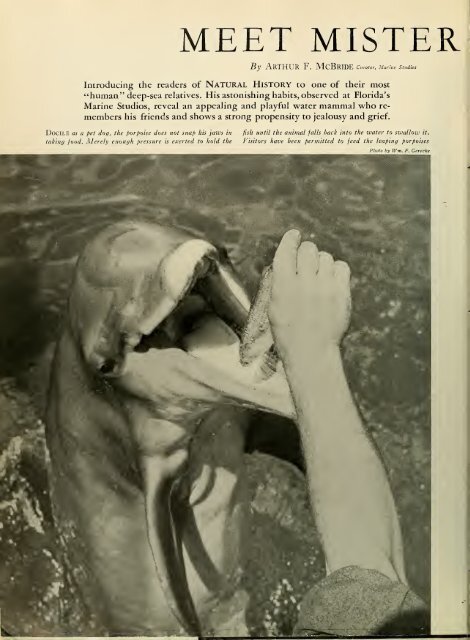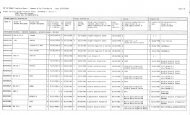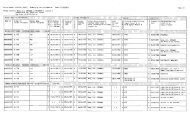Meet Mr. Porpoise - Ceta-Base
Meet Mr. Porpoise - Ceta-Base
Meet Mr. Porpoise - Ceta-Base
Create successful ePaper yourself
Turn your PDF publications into a flip-book with our unique Google optimized e-Paper software.
MEET MISTER<br />
By Arthur F. McBride curator, Man,<br />
Introducing the readers of NATURAL HISTORY to one of their most<br />
"human" deep-sea relatives. His astonishing habits, observed at Florida's<br />
Marine Studios, reveal an appealing and playful water mammal who remembers<br />
his friends and shows a strong propensity to jealousy and grief.<br />
Docile as a pet dog, the porpoise does not snap his jaws in<br />
taking food. Merely enough pressure is exerted to hold the<br />
fish until the animal falls back into the water to swallow it.<br />
Visitors have been permitted to feed the leaping porpoises<br />
Photo by Wm. F. Gerecke
PORPOISE<br />
Romance<br />
of the sea! What a fascination lies<br />
in ragged reefs, crashing combers, rusty<br />
freighters and all the flotsam that finds its<br />
way from 'Frisco to Rangoon New Bedford to<br />
Singapore. Yet of all the tall tales recounted by seagoing<br />
men perhaps none were so imaginative as those<br />
about whales, porpoises and dolphins. While scien-<br />
tists, working almost entirely from dead bodies, la-<br />
icquired a great deal of information upon<br />
difi<br />
n andspecial adaptations of > *<br />
mmals, the popular concept 7"^^—^\~T>^"~"^ ^~r"~Z<br />
. , ., , AlR VIEW of Marine Studios,<br />
has to a great extent remai<br />
/' Florida<br />
'<br />
raained a mass or fanciful , , ,.<br />
,<br />
.<br />
the world's largest aquaria tanks<br />
legends.<br />
Of course, the surging roll of a porpoise as it breaks<br />
water to breathe is a familiar sight in our own coastal<br />
waters as well as on the high seas. But the bulk of a<br />
porpoise's life, like the bulk of an iceberg, lies prin-<br />
cipally beneath the surface of the water. And, until<br />
March, 1938, no one had ever been able to study accu-<br />
rately this sub-surface existence. At this time the first<br />
porpoises were introduced into the newly-built cir-<br />
cular oceanarium at Marine Studios, Marineland,<br />
Florida, to begin a life of captivity under close ob-<br />
servation.<br />
What are the Marine Studios? What is the differ-<br />
ence between this enterprise and any other aquaria?<br />
The difference lies in the fact that at Marine Studios<br />
marine life is not segregated by species but placed to-<br />
" Portholes" beloiv water level give the visitor the nearest thing to a descent<br />
in diving helmet. All captive porpoises have learned to take food from the diver<br />
Photo by II m. F. Gereckt<br />
MEET MISTER PORPOISE 17
gether as it exists in the open sea. We therefore find<br />
in one tank sharks swimming side by side with a school<br />
of jacks, and a six-foot green moray coiled under the<br />
same rock that is home to a six-inch angel fish.<br />
Assume for a moment that we are guests for the<br />
day at Marineland. As we approach the giant tanks,<br />
we are astounded at the natural beauty of the place.<br />
The tanks themselves are built along the ocean front<br />
and to the east extends the broad expanse of the blue<br />
Atlantic. To the west the ground rises in lump contours<br />
of sand dunes and shell mounds, and rolls away<br />
to the Intra-Coastal Waterway shimmering in the<br />
bright Florida sunlight. Countless palms wave a<br />
friendly greeting and the white of the sand dunes is<br />
softened by cactus, yucca and seagrape.<br />
We approach the south end of the gigantic tanks<br />
and are directed to the main entrance. As we step<br />
into the lower corridor, soft blue lights lead us from<br />
porthole to porthole ; and through these windows we<br />
gaze in awe at the fascinating, colorful undersea<br />
world. The blue-green waters, pumped from the<br />
ocean at the rate of five million gallons per day, are<br />
iridescent and clear. The floor of the mammoth ocean-<br />
arium is covered with sand, sea shells and plumes.<br />
A seven-ton coral reef affords protection for the smaller<br />
specimens. A 300-pound turtle lumbers lazily over<br />
the coral reef, and great schools of shiny bumper fish<br />
follow in his path with the hopeful expectancy of find-<br />
ing a few scraps of food the big fellow might leave<br />
behind. From the stern of a shipwreck, the long<br />
sinewy shape of a shark electrifies the scene, and many<br />
of the smaller fish scuttle for cover. A huge ray gro-<br />
tesquely flaps his way over the sea fans while a spotted<br />
moray suspiciously eyes his passage from a safe sanctum<br />
in the coral.<br />
The 200 glass portholes, averaging 18 x 24 inches,<br />
encased in the steel tank walls, stand out like brightly<br />
lighted stages in the semi-dark corridors. Sitting in<br />
front of a porthole, the visitor is shielded from in-<br />
clement weather and outside distractions as the immense<br />
life of the ocean floor unfolds before him.<br />
In their large size also, the oceanariums are unique.<br />
The circular tank, the one in which the porpoises live,<br />
is 75 feet in diameter and twelve feet deep. The other<br />
is roughly rectangular and has a length of 100 feet,<br />
width of 40 feet and a maximum depth of 18 feet.<br />
Connecting the two, and serving as a quarantine for<br />
new specimens, is the shallow receiving tank.<br />
The design of this structure was conditioned by<br />
the three functions it was to perform. First, to offer<br />
the public the opportunity to observe the complexities<br />
of life under the surface of the sea. Second, to offer<br />
the motion picture industry the facilities for filming<br />
underwater action against an authentic background.<br />
Third, and most significant, to offer the scientific<br />
world the opportunity for study and investigation into<br />
the biological problems for which the facilities of the<br />
institution are most adequately fitted.<br />
To the visitors at Marine Studios, the bottle-nosed<br />
dolphin, commonly known as porpoise in American<br />
waters, is of greatest interest. The first view of the<br />
large gray animals, from underwater, completely<br />
transforms previous concepts of them.<br />
Battleship gray with its underbody a dull white,<br />
the porpoise embodies Nature's most streamlining<br />
effects. Observing them through the portholes, the<br />
visitor is amazed at the grace and speed which the<br />
porpoise attains. The tail of the porpoise, unlike that<br />
of any fish, beats up and down and by this perpendicu-<br />
lar motion, the supple flow of muscular effort through-<br />
out the entire body enables the porpoise to attain tremendous<br />
bursts of speed. Frequently after the animal<br />
has achieved momentum he will arch his back and<br />
glide across the tank; and often during courtship, the<br />
animal will barrel roll for some 20 to 30 feet.<br />
<strong>Porpoise</strong>s, of course, are primarily fish eaters, and<br />
in coastal Florida waters they feed principally on<br />
mullet. This readily obtained fish is fed to the porpoises<br />
here, and each adult eats at least 20 pounds<br />
daily.<br />
Two opportunities, to date, have been offered to<br />
observe the nursing and weaning of a young porpoise.<br />
The two originally captured in March, 1938, proved<br />
to be mother and daughter ; the young one beginning<br />
to nurse at once. Throughout the day and night the<br />
baby took nourishment at 15 to 30 minute intervals.<br />
When nursing, the young porpoise holds the end<br />
of its snout for about five seconds over the inverted<br />
nipple, which lies hidden in a fold in the blubber. By<br />
contraction of specialized muscles of the abdomen the<br />
parent forces the milk, which has collected in sinuses<br />
running lengthwise through the mammary tissue, into<br />
the mouth of the offspring. The whole operation can<br />
take place quickly, an obvious necessity, because young<br />
porpoises very rarely remain submerged, at least here<br />
in the oceanariums, for more than 30 seconds. Young<br />
nursing manatees, on the other hand, remain underwater<br />
for ten minutes and suckle in typical mammalian<br />
manner.<br />
Three weeks after capture, the young one began<br />
grasping fish in her mouth, and after playing with the<br />
fish for a few moments would drop it and pick up another.<br />
Once in the fourth week the young one was<br />
observed to swallow at least one fish.<br />
The following day the baby was in distress. The<br />
dull eyes and listless form bespoke complete misery.<br />
Frequently the young porpoise vomited, and each time<br />
the attendant parent rubbed the stomach of the little<br />
one steadily with her snout. By late afternoon the at-<br />
tack passed, leaving the young one completely fatigued.<br />
18 NATURAL HISTORY, JANUARY, 1940
All during rliis period the babj was receiving nourishment<br />
from her parent. In the eleventh week, how-<br />
ever, she again swallowed small mullet. During tin-<br />
next three weeks the amount of fish consumed rose to<br />
about ten pounds. The young one, however, fre-<br />
quently attempted to nurse until the fourteenth week.<br />
The second nursing porpoise to be studied in the<br />
tanks was captured with her mother in July, 1939.<br />
About a month after capture, the female appeared to<br />
go dry. The young one, however, made frequent at-<br />
tempts to obtain milk. For a ten-day period the little<br />
one went apparently without nourishment and lust<br />
much weight. Finally she started eating a few fisb a<br />
day, but swallowed them with considerable effort.<br />
Within a week she was eating up to ten pounds per<br />
day and was competing successfully with the adult<br />
porpoises. At this writing, she is healthy and filling<br />
out rapidly.<br />
The portion of the brain devoted to receiving<br />
sensations of sound, we learn, is particularly well<br />
developed in the porpoise. It is extremely interesting,<br />
therefore, to watch the behavior of an animal whose<br />
principal concept of his surroundings comes to him<br />
through his auditory apparatus.<br />
The auditory apparatus has been considerably<br />
modified in the case of these sea-going mammals. No<br />
outer ear is visible on the head of the porpoise. If we<br />
look closely, however, in the region a few inches be-<br />
hind and lower than the eye, we notice an almost in-<br />
visible opening, the rudiment of the auditory canal.<br />
In the case of the animal we are watching, it is scarcely<br />
large enough to permit the entrance of a toothpick.<br />
Water is an excellent conductor of sound. This<br />
closure of the auditory canal, therefore, does not im-<br />
pair the animal's sense of hearing, as sound vibrations<br />
are carried directly to the bones of the skull. The por-<br />
poise is interested principally in the sounds trans-<br />
mitted through water, and has been able to close his<br />
external auditory canal without endangering his<br />
survival.<br />
The importance that this sense of hearing plays in<br />
feeding has been particularly interesting. The first<br />
porpoise to be captured and placed in the tanks here<br />
in March, 1938, showed no interest whatsoever in<br />
dead fish that were presented to him. Accidentally,<br />
however, it was discovered that if the fish hit the<br />
water broadside, with a splash, it was immediately<br />
taken by the porpoise. Thereafter, fish were slapped<br />
on the surface several times and were then thrown to<br />
the porpoise in such a manner that they landed broad-<br />
side on the water. The significance of this discovery<br />
is interesting because we know that here in the murky<br />
inland waters of the Florida coast, mullet frequently<br />
leap clear of the water to land on the surface with a<br />
splash. The possibility is offered, therefore, that the<br />
J let.<br />
The importance that sound plays in the life<br />
porpoise lias ] (-d to much discussion about the<br />
of communication among whales, dolph<br />
siderable reference- have been made in literature to<br />
or calls uttered bj ing mammals.<br />
particularly, when harpooned oi<br />
OVeries made at Marine Studio- with<br />
porpoises was that the animals are capa<br />
A sharp whistling sound was clearly evident in the<br />
corridors surrounding the circular tank after the first<br />
bottle-nosed dolphin was introduced. The sound was<br />
-0011 noted to be caused by the 1 air from the<br />
blowhole. Subsequent observations led to the :<br />
tion that the sharp whistling sound made by porpoises<br />
was possiblj similar in origin.<br />
During the first week or two of captivity all of the<br />
specimens whistled constantlj and swam about the<br />
tank nervously. Afterthey became acclimated, bow ever,<br />
the whistling was heard less frequently and appar-<br />
ent [j served as a method of communication. I<br />
mals made this sound less frequently during the day-<br />
light than at night.<br />
Apparently the animals used variations in this whis-<br />
tling sound to indicate different emotional states.<br />
L sually when one or several of the animals w ere chas-<br />
ing a live fish, they would be whistling excitedly.<br />
When any disturbing object, such as a net. was pres-<br />
ent, this was also true. This sound was transmitted<br />
well through water and was heard distinctly in the<br />
corridors surrounding our tanks above the scuffling<br />
of feet and the chatter of voices.<br />
A\ hen it was necessary to move two porpoises, the<br />
original mother and daughter, from the rectangular<br />
tank into the circular one, a very clear example of the<br />
function of the sound was obtained. The parent was<br />
netted first and moved through the shallow connecting<br />
tank into the circular. The water level was then<br />
lowered in order to catch the young one. The two<br />
animals remained in their respective tanks close to the<br />
wire mesh gates that separated them from each other,<br />
the young one whistling madly and the parent fre-<br />
quently answering her. As soon as the water level in<br />
the two tanks dropped low enough, so that the con-<br />
necting tank was dry, and the watery, and therefore<br />
sound-conducting connection between the two tanks<br />
was severed, the parent left her position at the gate<br />
and swam about the whole tank, even showing some<br />
interest in chasing live fish. The young one persisted<br />
in whistling as loudly as ever although the parent<br />
never whistled again after she was unable to hear the<br />
young one. Within a short time the young one was<br />
captured and placed in the tank with its parent, where<br />
they joyfully renewed their life together.<br />
MEET MISTER PORPOISE J 9
photo by "'<br />
(Left) The concrete<br />
SHELL surrounding the<br />
steel tanks encloses observation<br />
corridors.<br />
Stairiuays lead to a top<br />
deck from which the<br />
surface of the tanks can<br />
be viewed. Flocks of<br />
pelicans pass overhead<br />
continually and egrets<br />
dot the marsh expanses<br />
to the west<br />
(Right) A NEWLY-CAPTURED porpoise in the well of the collecting<br />
boat <strong>Porpoise</strong>. The steel doors at the distant end of the ivell open to<br />
the sea through the stern making it possible to bring large specimens in<br />
under water. The pad and sling at the left will be placed under the<br />
porpoise preparatory to hoisting<br />
Anyone who has swum under water knows how<br />
poorly we can see beneath the surface. How then can<br />
the porpoises and whales, which were once land crea-<br />
tures, pursue their submarine existence?<br />
A frequently observed fact, has been that whales,<br />
such as the killer, raise their heads out of water at<br />
the edge of ice floes, apparently looking for prey. The<br />
captive dolphins at Marine Studios frequently peer,<br />
head out of water, and undoubtedly perceive with<br />
some degree of definition, moving objects at a dis-<br />
tance of at least 50 feet.<br />
Whenever anyone walks out on the feeding plat-<br />
(Below) Young porpoise about to catch a live fish while<br />
"Ma" looks on approvingly. When live fish are introduced<br />
the animals work together and herd the school against the<br />
ivall where they can be more easily caught<br />
Photo by Wtn. F. Gerecke<br />
Photo by <strong>Mr</strong>s. C. V. Whit<br />
form, whether carrying food or not, all the porpoises<br />
gather in anticipation, raising half their bodies out of<br />
water as they follow the movements of the human.<br />
One of our young porpoises, which became very tame,<br />
was a particularly keen observer of above water ac-<br />
tivity. While this young one was resting at the surface,<br />
its attention could be attracted by a hand waving<br />
at a distance of 50 feet. The animal would come rac-<br />
ing across the tank and leap out of water to investigate<br />
the waving object.<br />
All porpoises after being acclimated to captivity<br />
will follow a fish thrown through the air 20 feet<br />
The single closed blowhole shows up prominently on<br />
the heads of these porpoises. The large animal in the cen-<br />
ter is an adult female, and her young nursing offspring<br />
follows in typical manner close behind<br />
Photo by <strong>Mr</strong>s. C. V. Whitney<br />
NATURAL HISTORY, JANUARY, 194O
( o 'i BLY i DLI P in canva tin porp<br />
been transported from the dock ii, the octanarium<br />
in a special truck. I hoist then lift tin qu<br />
animal up to tin ' eceh ing tank. Being an air-<br />
breathing mammal flu porpo'tSi Can l>, kept '-lit of<br />
ati ' for long period<br />
Whitney<br />
above the water, by swimming on their sides, heads<br />
out of water, and intently watching the fi>h with the<br />
exposed eye. Occasionally they catch the fish in their<br />
mouths, but usually only arrive in the general region<br />
in which the fish lands. That the) recognize the fly-<br />
ing object as a fish is improbable, because the tamer<br />
ones will leap just as high out of water to take the<br />
keeper's empty hand as they will to take a fish. After<br />
a few unrewarded leaps, however, they will refuse to<br />
jump until the reward is again given.<br />
Underwater it is more difficult to determine the<br />
extent of the bottle-nosed dolphin's vision. Because<br />
the water in the tank is of exceptional clarity, the ob-<br />
server is usually able to recognize objects on the far<br />
A YOUNG PORPOISE at Marine Studios takes a mullet near<br />
the surface. The light scattered by the rippled surface com-<br />
pletely breaks up the form of the animal and at a distance<br />
-.idt- of the tan.<br />
observations that thi<br />
the tank, but no direct evidence bi I > le '<br />
the fact that the turbidit) i<br />
near<br />
Marine-<br />
land is usually twenty-five ter than that in<br />
tin- tanks, the possibility led vision in<br />
nature are considerabl) less than the) arc for animals<br />
in captn itj<br />
All mammals require sleep in order to live and it<br />
is therefore not surprising to find that the porpoises<br />
spend definite periods throughout the da) and night<br />
completer) relaxed. The animals, during these periods<br />
of relaxation, always remain motionless at the sur-<br />
face, the top portion of the head, including the blow-<br />
hole, exposed to the air. The tail portion of the body,<br />
ha
This photograph was taken when the original<br />
mother and daughter were being trained. A few moments<br />
later, the adult took the author's right foot in<br />
(Left) The new arrival is gently lowered into the receiv-<br />
ing tank. During this handling, the mammals remain remarkably<br />
quiet and suffer no injuries to their sensitive skins<br />
(Below) An attendant assists the animal from the canvas<br />
sling. New arrivals are kept in this tank for weeks, where<br />
they lose fear of man and feed freely. They are then better<br />
able to compete with older residents in the large tank<br />
her mouth and started off. As soon as she realized<br />
her mistake, however, the foot was released with<br />
scarcely a scratch<br />
Photo by U'm. F. Ge
Apparentlj the females float more efficicntlj than<br />
the males, and in the case of all female pe imens,<br />
t h
to have a complete understanding of the position of<br />
the various animals in the social order.<br />
We have found that new arrivals in the tank, if<br />
smaller, were chased and frequently bitten by the<br />
older residents. As mentioned previously, in October,<br />
1938, two young animals were introduced and were<br />
never completely tolerated by the adult female. At<br />
that time the adult female and young offspring were<br />
the only residents in the tanks. In January, 1939, two<br />
adult male porpoises were introduced into the tank<br />
after the adult female had lost her young one. From<br />
the beginning there was no question that the larger<br />
of these two males was the dominant one.<br />
Courtship activity began immediately, and although<br />
the smaller male was definitely subordinated<br />
to the larger, it in no way lessened his activity during<br />
the courtship period. Less than two weeks after the<br />
two males were introduced, a smaller male, seven<br />
and one-half feet in length, was captured. The two<br />
large ones immediately persecuted him and during<br />
the first few days he was bitten several times. Because<br />
of his agility, however, he was able to avoid the two<br />
larger males.<br />
Within a few weeks, he was more or less accepted<br />
by the other porpoises, and was milling around the<br />
feeding attendant's platform during feeding time.<br />
poises at Marine<br />
Studios are curious about activity<br />
on the top deck and<br />
frequently raise their heads<br />
above water. While in this<br />
position they can be attracted<br />
by a waving hand or other<br />
moving object, and the visitor<br />
can induce the porpoises to<br />
leap out of the water for a<br />
photograph. They also gather<br />
in this manner before each<br />
feeding<br />
Photo by Wm. F. Gerecke<br />
This TRIO, an adult and a young bottle-nosed dol- When they were placed in the circular oceanaphin<br />
and one spotted dolphin, were captured at rium, the spotted persisted in following the other<br />
about the same time and were kept together in two for several days in spite of protests on the<br />
the receiving tank for a short training period.<br />
part of the adult bottle-nosed<br />
Photo by <strong>Mr</strong>s. C. V. Whitney
This small male never indulged in anj oi the couri<br />
ship displays of the large: males, and as long as he<br />
remained al a di itanl ide ol I he tank he •<br />
,<br />
bothered by them. Even during the sleeping periods<br />
the young male was careful to remain on 'lie side of<br />
the lank opposite from the other two.<br />
The principal form of intimidation was a loud<br />
snapping of the jaws which, when a dominant animal<br />
did it, was almost always sufficient to scare the sub-<br />
missive one away. Frequently all that was neci<br />
was the assumption of a posture like that taken bj a<br />
porpoise when preparing to get under waj quickly.<br />
Because the two males were captured together, ap-<br />
parently their social relationship hail been determined<br />
previously. One was about nine feet in length, the<br />
other eight and one-hall, and there could be little<br />
question that during the feeding and courtship activity<br />
the larger one was the more dominant. There was<br />
practically no fighting between the two, and, aside<br />
from occasional jaw-snapping on the part of the<br />
larger, the two were very peaceable. During the court-<br />
r ih, In i "bat •<br />
inn! vi<br />
'.<br />
'I 111 I<br />
I I' IRPOISE s Mll.i . '1' lin<br />
it'' 1 alike.<br />
()n, \u inn/ porpOlSl ',iil did II,, I);,, in I-<br />
iief 11/ snapping prevented thi<br />
to staff<br />
from Initial/ 1,11 the li«i In- i
Young PORPOISE leaping for food. This animal has been knoivn<br />
to clear the water completely when particularly energetic<br />
ship activity neither of the males would permit the<br />
other to leave for even a few seconds.<br />
In February the smaller of the two large males<br />
was removed from the tank and transported by means<br />
of our tank truck to Tampa. It was exhibited there<br />
under the auspices of the State Conservation Department<br />
in a concrete tank for three weeks. After being<br />
brought back by truck, it was again placed in the cir-<br />
cular tank. When the animal was released into the<br />
tank, the greatest amount of excitement on the part<br />
of the larger male was exhibited. No doubt could exist<br />
that the two recognized each other, and for several<br />
hours they swam side by side rushing frenziedlv<br />
through the water, and on several occasions they<br />
leaped completely out of the water. For several days,<br />
the two males were inseparable and neither paid anv<br />
attention to the female.<br />
From our limited experience with the bottle-nosed<br />
dolphin, we find it difficult to ascribe any definite mat-<br />
ing season for the species. Courtship was first observed<br />
when the first two males, previously mentioned, were<br />
placed in the tank with the lone adult female. Court-<br />
ship activity began immediately with several forms<br />
of display by the males. Both would come gliding<br />
across the tank, usually swimming upside down, fre-<br />
(Below) The spotted dolphin sleeping. Slow beats<br />
of the tail enable him to maintain his position<br />
26 NATURAL HISTORY, JANUARY, 1 94O
(|iicnil\ w it 1 1 inoiitlis « ill i- open and 01 1 asionally snap-<br />
ping their jaws together. Often the males would al<br />
tempi to buti the female, bul neithei evei attempted<br />
in bite her. One male, ;is mentioned above, would<br />
never permit the other to gel out of si^ln and the two<br />
constantly pursued the female foi a<br />
-<br />
><br />
• 1 i *<br />
• < 1<br />
i of two<br />
weeks.<br />
In March another adult female was captured and<br />
placed in the tank. The same courtship activity was<br />
displayed again. This time only one adult male was<br />
present.<br />
The period of gestation for any <strong>Ceta</strong>cean (pro<br />
nounced see-tay'-shean) is not definitely known.<br />
Considerable interest is therefore attached to the fact<br />
that the porpoises here have mated. It is hoped that<br />
the near future will witness the birth of a porpoise.<br />
From observations on the animal for a period of a<br />
year and a half, the observer cannot help feeling that<br />
the animal possesses a high degree of intelligence. Ii<br />
is hoped that the future will bring about the oppor-<br />
tunity to test accurately the mental abilities ot these<br />
captured <strong>Ceta</strong>ceans.<br />
The fact that these animals not only readily learned<br />
to take food, but also quickly lost their fear of the<br />
feeding attendant is a tribute to their adaptability.<br />
(Below) Male porpoise, at right, warns new arrivals<br />
at Marine Studios that he is boss by snapping jaws<br />
MEET MISTER PORPOISE<br />
During the Inst moot:, and a half of their<br />
the adult and bain original 1) i aught<br />
lei<br />
food from the hand of th( but also<br />
to raise their heads out of the vatei B •<br />
ei ond iconv jumping th i<br />
end of the<br />
their lengths out oi Ice food. Since that<br />
time evcral otl i<br />
learned<br />
to do like-<br />
i e<br />
During e original pai<br />
(Above) A I'H.Mi sperm whale i<br />
Kogia breviceps) washed ashore<br />
near Marine/and in a storm lived only a few hours
tivity, they were also found to be curious about a<br />
human swimming underwater with them. In the short<br />
training period they learned to come over and take<br />
fish from such a person's hand. Within a short time<br />
after, they also learned to take food from the hand<br />
of a diver walking on the bottom in a shoulder helmet.<br />
The original young porpoise, in fact, frequently annoyed<br />
the diver when he was going about his daily<br />
window cleaning duties, by playfully nibbling at his<br />
feet.<br />
This young one was also keen about playing with<br />
any human, whether a stranger or not, and would<br />
come to the surface and gently nibble a hand which<br />
was offered to her. The young one also delighted in<br />
being scratched on the belly, and would repeatedly<br />
come back and roll on her side at the surface for more.<br />
Partially deflated rubber balls were kept in the tank<br />
solely for the amusement of the young porpoise. She<br />
would grab the ball in her mouth, pull it below water<br />
and release it. Her eyes intensely followed the ball as<br />
These two porpoises learned to eat from a plate but al<br />
ways took the food below water to swallow it. They swallow<br />
fish without chewing, head-first. The minute openings<br />
it rose to the surface and bounded out of water. Many<br />
other objects in the tank excited the curiosity of the<br />
young porpoise, including turtles of all sizes from 25<br />
to 300 pounds. The young one was noted on several<br />
occasions to tip a 50 pound loggerhead turtle up, so<br />
that its body lay in a vertical plane, and push it com-<br />
pletely across the tank at the end of her snout.<br />
The baby's playfulness, however, was her undoing.<br />
In the early fall of 1938, two manatees were placed<br />
in the tank—an adult female and her young nursing<br />
offspring. The manatees tamed quickly, and soon<br />
learned to come to the surface to eat eel grass from<br />
the hand of the keeper. On these occasions the two<br />
porpoises, particularly the young ones, would butt the<br />
manatees persistently, until they retreated. The<br />
young one carried this jealous activity even further<br />
and would take eel grass from the mouth of the young<br />
manatee and streak across the tank shaking the grass<br />
throughout the water with a sidewise motion of her<br />
head.<br />
behind the eye are the rudiments of the ear opening. They<br />
are scarcely large enough to permit the entrance of a<br />
toothpick<br />
Plwto by V/m. F. Gerecke
'I III PORPOISES do not tale u run<br />
ning start in order to leap u/> for<br />
fund. They start from the surface<br />
and drive themselves steadily up<br />
ward by powerful sweeps of /lien tail.<br />
1 1 is therefore possible for a porpoise<br />
to hold the position at right for sev-<br />
eral seconds. Should one lose balance<br />
while suspended in air, however, he<br />
almost invariably falls bat kward,<br />
thus avoiding the possibility of in-<br />
jury against the steps of the feeding<br />
platform<br />
Photo hy<br />
Ncllitjan Masters<br />
In early December, the young porpoise's appetite<br />
began to fail. A castor oil treatment was finally re-<br />
sorted to. On the morning after Christmas, however,<br />
the lifeless body of the young one was found being<br />
supported at the surface by the bereaved parent, presumably<br />
so that if life yet remained in the porpoise it<br />
could breathe the necessary air. How long the parent<br />
had held the body at the surface was not known, but<br />
for several days following she showed unmistakable<br />
signs of grief. The young porpoise's stomach was<br />
found to be stuffed solid with undigested eel grass.<br />
Although the animal had never been observed to swallow<br />
the grass, it must have done so during the fre-<br />
quent thefts of the manatee's food.<br />
A dinner bell is habitually rung underwater at the<br />
beginning of each feeding, but the porpoises have other<br />
means of knowing when the feeding time approaches,<br />
because they are always on hand in front of the feed-<br />
ing platform with heads raised out of water, at least<br />
ten minutes before the feeding is to begin. Because<br />
crowds always gather on the top deck before each feed-<br />
ing, their presence affords a cue to the animals ; but<br />
on rainy days when the visitors do not stay on the top<br />
deck, the porpoises still gather in anticipation of the<br />
feeding.<br />
At each feeding, a diver also goes in the water to<br />
feed the animals by hand, and, although animals such<br />
as large turtles, jewfishes and sting rays, actually bite<br />
the diver's body in their enthusiasm for food, the por-<br />
poises always remain poised and waiting for the food<br />
to be offered to them. They also wait their turn and<br />
practically never attempt to shoulder each other out<br />
of the way. This is not true, however, when fish is<br />
being thrown to them at the surface, because in those<br />
cases several swim for the fish and the fastest gets it.<br />
Recently, a large manta ray with a wing spread of<br />
thirteen feet has been living in the oceanarium with<br />
the porpoises. This ray circled the edge of the tank<br />
constantly 24 hours a day. This greatly disturbed the<br />
sleeping porpoises because they were accustomed to<br />
sleeping in the same region in which the manta now<br />
swam. For the first two days the porpoises did not get<br />
much rest but soon proved their adaptability by restricting<br />
their sleeping to the center of the tank where<br />
the manta seldom intruded.<br />
Fascinating visitors by their almost continual ac-<br />
tivity at all hours of the day, the porpoise school is an<br />
outstanding wildlife exhibit. The adaptability of the<br />
mammals as a laboratory subject has been proved, and<br />
investigations into their physiology have begun. By<br />
the provision of adequate laboratory facilities and the<br />
subsequent attraction of specialists in the fields of<br />
mammalian physiology and behavior, the earnest hope<br />
of Marine Studios is, that its unique facilities will<br />
offer the means of elucidating the life habits of these<br />
highly specialized mammals—the <strong>Ceta</strong>cea.<br />
MEET MISTER PORPOISE 29











